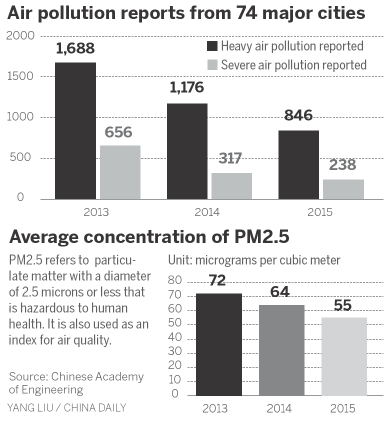2017 pollution targets 'in reach'
Updated: 2016-07-06 07:40
By Zheng Jinran(China Daily)
|
|||||||||
Most provinces have performed well, according to assessment, but Beijing faces tough challenge
A majority of Chinese provinces have performed well in reducing airborne pollutants and have a good chance of reaching the targets set in the national action plan by 2017, according to an assessment by the Chinese Academy of Engineering that was released on Tuesday.
However, Beijing appears to have a tough challenge ahead, according to the assessment.
China has been engaged since 2013 in a national campaign against smog. The Action Plan on Air Pollution Prevention and Control set emission reduction targets to be met by 2017.
The plan said all cities should cut their PM10 levels by 10 percent, and that three major zones-Beijing-Tianjin-Hebei, the Yangtze River Delta and the Pearl River Delta-should cut PM2.5 by 15 to 25 percent. PM2.5 and PM10 refer to hazardous particulate matter.
To assess the midterm performance of the action plan, the Ministry of Environmental Protection authorized the engineering academy to conduct the assessment.
"Most provinces have finished the major tasks, and reduction of particulate matter has reached or surpassed the midterm targets, which puts the 2017 goals in reach," said Hao Jiming, an environmental studies academician at Tsinghua University who led the assessment.
The assessment said major airborne pollutants including PM2.5 and sulfur dioxide have been reduced greatly, and the days with good air quality have increased nationwide.
But the assessment also exposed some problems. For example, seven provinces, including Liaoning and Jilin, not only failed to reduce PM10 concentrations but saw increases.
Beijing, which has faced a tough challenge in meeting the 2017 goals, was supposed to reduce PM2.5 to 60 micrograms per cubic meter on average, but its concentration last year averaged 80.6.
"The current control efforts in Beijing were not strong enough to facilitate such a large cut in PM2.5," said He Kebin, dean of the School of Environment at Tsinghua University.
Beijing plans to replace coal consumption for winter heating with electricity, which generates less pollution, in its rural areas and some areas of neighboring Langfang and Baoding cities, as well as some cities in Hebei province within 18 months, He said.
The reduction of coal burning is one of Beijing's difficult challenges, but success would enable the capital to reach its 2017 goals, He said.
 |
|
Air pollution reports from 74 major cities.[Yang Liu/China Daily] |
Today's Top News
Conservatives begin selecting next prime minister
Suicide bombers hit three Saudi cities
Response to 'fully depend' on Manila
UKIP leader Farage says will step down
Bangladesh pays state tribute to Dhaka attack victims
Rome shows off cleaned up Colosseum
Thousands march against Brexit in London
China-UK ties to remain strong despite Brexit: envoy
Hot Topics
Lunar probe , China growth forecasts, Emission rules get tougher, China seen through 'colored lens', International board,
Editor's Picks

|

|

|

|

|

|







